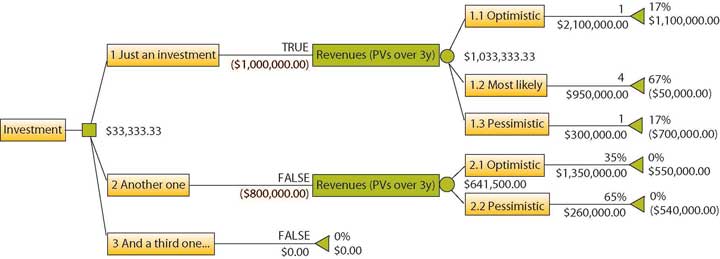7.3: Decision Making in Groups
- Last updated
- Save as PDF
- Page ID
- 9493
Learning Objectives
- Understand the pros and cons of individual and group decision making.
- Learn to recognize the signs of groupthink.
- Recognize different tools and techniques for making better decisions.
When It Comes to Decision Making, Are Two Heads Better Than One?
The answer to this question depends on several factors. Group decision making has the advantage of drawing from the experiences and perspectives of a larger number of individuals. Hence, a group may have the potential to be more creative and lead to more effective decisions. In fact, groups may sometimes achieve results beyond what they could have done as individuals. Groups may also make the task more enjoyable for the members. Finally, when the decision is made by a group rather than a single individual, implementation of the decision will be easier, because group members will be more invested in the decision. If the group is diverse, better decisions may be made, because different group members may have different ideas based on their backgrounds and experiences. Research shows that for top management teams, diverse groups that debate issues make decisions that are more comprehensive and better for the bottom line (Simons, Pelled, & Smith, 1999).
Despite its popularity within organizations, group decision making suffers from a number of disadvantages. We know that groups rarely outperform their best member (Miner, 1984). While groups have the potential to arrive at an effective decision, they often suffer from process losses. For example, groups may suffer from coordination problems. Anyone who has worked with a team of individuals on a project can attest to the difficulty of coordinating members’ work or even coordinating everyone’s presence in a team meeting. Furthermore, groups can suffer from groupthink. Finally, group decision making takes more time compared to individual decision making, because all members need to discuss their thoughts regarding different alternatives.
Thus, whether an individual or a group decision is preferable will depend on the specifics of the situation. For example, if there is an emergency and a decision needs to be made quickly, individual decision making might be preferred. Individual decision making may also be appropriate if the individual in question has all the information needed to make the decision and if implementation problems are not expected. On the other hand, if one person does not have all the information and skills needed to make a decision, if implementing the decision will be difficult without the involvement of those who will be affected by the decision, and if time urgency is more modest, then decision making by a group may be more effective.
Figure 11.11 Advantages and Disadvantages of Different Levels of Decision Making
| Individual Decision Making | Group Decision Making | ||
|---|---|---|---|
| Pros | Cons | Pros | Cons |
| Typically faster than group decision making | Fewer ideas | Diversity of ideas and can piggyback on others’ ideas | Takes longer |
| Best individual in a group usually outperforms the group | Identifying the best individual can be challenging | Greater commitment to ideas | Group dynamics such as groupthink can occur |
| Accountability is easier to determine | Possible to put off making decisions if left alone to do it | Interaction can be fun and serves as a teambuilding task | Social loafing–harder to identify responsibility for decisions |
Groupthink

Have you ever been in a decision-making group that you felt was heading in the wrong direction but you didn’t speak up and say so? If so, you have already been a victim of groupthink. Groupthink is a tendency to avoid a critical evaluation of ideas the group favors. Iriving Janis, author of a book called Victims of Groupthink, explained that groupthink is characterized by eight symptoms (Janis, 1972):
- Illusion of invulnerability is shared by most or all of the group members, which creates excessive optimism and encourages them to take extreme risks.
- Collective rationalizations occur, in which members downplay negative information or warnings that might cause them to reconsider their assumptions.
- An unquestioned belief in the group’s inherent morality occurs, which may incline members to ignore ethical or moral consequences of their actions.
- Stereotyped views of outgroups are seen when groups discount rivals’ abilities to make effective responses.
- Direct pressure is exerted on any members who express strong arguments against any of the group’s stereotypes, illusions, or commitments.
- Self-censorship occurs when members of the group minimize their own doubts and counterarguments.
- Illusions of unanimity occur, based on self-censorship and direct pressure on the group. The lack of dissent is viewed as unanimity.
- The emergence of self-appointed mindguards happens when one or more members protect the group from information that runs counter to the group’s assumptions and course of action.
OB Toolbox: Recommendations for Avoiding Groupthink
- Groups should do the following:
- Discuss the symptoms of groupthink and how to avoid them.
- Assign a rotating devil’s advocate to every meeting.
- Invite experts or qualified colleagues who are not part of the core decision-making group to attend meetings and get reactions from outsiders on a regular basis and share these with the group.
- Encourage a culture of difference where different ideas are valued.
- Debate the ethical implications of the decisions and potential solutions being considered.
- Individuals should do the following:
- Monitor personal behavior for signs of groupthink and modify behavior if needed.
- Check for self-censorship.
- Carefully avoid mindguard behaviors.
- Avoid putting pressure on other group members to conform.
- Remind members of the ground rules for avoiding groupthink if they get off track.
- Group leaders should do the following:
- Break the group into two subgroups from time to time.
- Have more than one group work on the same problem if time and resources allow it. This makes sense for highly critical decisions.
- Remain impartial and refrain from stating preferences at the outset of decisions.
- Set a tone of encouraging critical evaluations throughout deliberations.
- Create an anonymous feedback channel through which all group members can contribute if desired.
Sources: Adapted and expanded from Janis, I. L. (1972). Victims of groupthink. New York: Houghton Mifflin; Whyte, G. (1991). Decision failures: Why they occur and how to prevent them. Academy of Management Executive, 5, 23–31.
Tools and Techniques for Making Better Decisions
Nominal Group Technique (NGT) was developed to help with group decision making by ensuring that all members participate fully. NGT is not a technique to be used routinely at all meetings. Rather, it is used to structure group meetings when members are grappling with problem solving or idea generation. It follows four steps (Delbecq, Van de Ven, & Gustafson, 1975). First, each member of the group begins by independently and silently writing down ideas. Second, the group goes in order around the room to gather all the ideas that were generated. This process continues until all the ideas are shared. Third, a discussion takes place around each idea, and members ask for and give clarification and make evaluative statements. Finally, group members vote for their favorite ideas by using ranking or rating techniques. Following the four-step NGT helps to ensure that all members participate fully, and it avoids group decision-making problems such as groupthink.

Delphi Technique is unique because it is a group process using written responses to a series of questionnaires instead of physically bringing individuals together to make a decision. The first questionnaire asks individuals to respond to a broad question such as stating the problem, outlining objectives, or proposing solutions. Each subsequent questionnaire is built from the information gathered in the previous one. The process ends when the group reaches a consensus. Facilitators can decide whether to keep responses anonymous. This process is often used to generate best practices from experts. For example, Purdue University Professor Michael Campion used this process when he was editor of the research journal Personnel Psychology and wanted to determine the qualities that distinguished a good research article. Using the Delphi technique, he was able to gather responses from hundreds of top researchers from around the world and distill them into a checklist of criteria that he could use to evaluate articles submitted to his journal, all without ever having to leave his office (Campion, 1993).
Majority rule refers to a decision-making rule in which each member of the group is given a single vote and the option receiving the greatest number of votes is selected. This technique has remained popular, perhaps due to its simplicity, speed, ease of use, and representational fairness. Research also supports majority rule as an effective decision-making technique (Hastie & Kameda, 2005). However, those who did not vote in favor of the decision will be less likely to support it.
Consensus is another decision-making rule that groups may use when the goal is to gain support for an idea or plan of action. While consensus tends to require more time, it may make sense when support is needed to enact the plan. The process works by discussing the issues at hand, generating a proposal, calling for consensus, and discussing any concerns. If concerns still exist, the proposal is modified to accommodate them. These steps are repeated until consensus is reached. Thus, this decision-making rule is inclusive, participatory, cooperative, and democratic. Research shows that consensus can lead to better accuracy (Roch, 2007), and it helps members feel greater satisfaction with decisions (Mohammed & Ringseis, 2001). However, groups take longer with this approach, and if consensus cannot be reached, members tend to become frustrated (Peterson, 1999).
OB Toolbox: Perform a Project “Premortem”
Doctors routinely perform postmortems to understand what went wrong with a patient who has died. The idea is for everyone to learn from the unfortunate outcome so that future patients will not meet a similar fate. But what if you could avoid a horrible outcome before it happened by proactively identifying project risks? Research has shown that the simple exercise of imagining what could go wrong with a given decision can increase people’s ability to correctly identify reasons for future successes or failures by 30% (Mitchell, Russo, & Pennington, 1989). A “premortem” is a way to imagine what might go wrong and avoid it before spending a cent or having to change course along the way. Gary Klein, an expert on decision making in fast-paced, uncertain, complex, and critical environments, recommends that decision makers follow a five-step process to increase their chances of success.
- A planning team comes up with an outline of a plan, such as the launching of a new product.
- Either the existing group or a unique group is then told to imagine looking into a crystal ball and seeing that the new product failed miserably. They then write down all the reasons they can imagine that might have led to this failure. Each team member shares items from their list until all the potential problems have been identified.
- The list is reviewed for additional ideas.
- The issues are sorted into categories in the search for themes.
- The plan should then be revised to correct the flaws and avoid these potential problems.
This technique allows groups to truly delve into “what if” scenarios. For example, in a premortem session at a Fortune 500 company, an executive imagined that a potential billion-dollar environmental sustainability project might fail because the CEO had retired.
Sources: Breen, B. (2000, August). What’s your intuition? Fast Company, 290; Klein, G. (2007, September). Performing a project premortem. Harvard Business Review, 85, 18–19; Klein, G. (2003). The power of intuition: How to use your gut feelings to make better decisions at work. New York: Random House; Pliske, R., McCloskey, M., & Klein, G. (2001). Decision skills training: Facilitating learning from experience. In E. Salas & G. Klein (Eds.), Linking expertise and naturalistic decision making (pp. 37–53). Mahwah, NJ: Lawrence Erlbaum Associates.
Group Decision Support Systems (GDSS) are interactive computer-based systems that are able to combine communication and decision technologies to help groups make better decisions. Research shows that a GDSS can actually improve the output of groups’ collaborative work through higher information sharing (Lam & Schaubroeck, 2000). Organizations know that having effective knowledge management systems to share information is important, and their spending reflects this reality. Businesses invested $2.7 billion into new systems in 2002, and projections were for this number to double every 5 years. As the popularity of these systems grows, they risk becoming counterproductive. Humans can only process so many ideas and information at one time. As virtual meetings grow larger, it is reasonable to assume that information overload can occur and good ideas will fall through the cracks, essentially recreating a problem that the GDSS was intended to solve, which is to make sure every idea is heard. Another problem is the system possibly becoming too complicated. If the systems evolve to a point of uncomfortable complexity, it has recreated the problem. Those who understand the interface will control the narrative of the discussion, while those who are less savvy will only be along for the ride (Nunamaker et al., 1991). Lastly, many of these programs fail to take into account the factor of human psychology. These systems could make employees more reluctant to share information because of lack of control, lack of immediate feedback, or the fear of online “flames.”
Decision trees are diagrams in which answers to yes or no questions lead decision makers to address additional questions until they reach the end of the tree. Decision trees are helpful in avoiding errors such as framing bias (Wright & Goodwin, 2002). Decision trees tend to be helpful in guiding the decision maker to a predetermined alternative and ensuring consistency of decision making—that is, every time certain conditions are present, the decision maker will follow one course of action as opposed to others if the decision is made using a decision tree.

Key Takeaways
There are trade-offs between making decisions alone and within a group. Groups have a greater diversity of experiences and ideas than individuals, but they also have potential process losses such as groupthink. Groupthink can be avoided by recognizing the eight symptoms discussed. Finally, there are a variety of tools and techniques available for helping to make more effective decisions in groups, including the nominal group technique, Delphi technique, majority rule, consensus, GDSS, and decision trees.
Exercises
- Do you prefer to make decisions in a group or alone? What are the main reasons for your preference?
- Have you been in a group that used the brainstorming technique? Was it an effective tool for coming up with creative ideas? Please share examples.
- Have you been in a group that experienced groupthink? If so, how did you deal with it?
- Which of the decision-making tools discussed in this chapter (NGT, Delphi, and so on) have you used? How effective were they?
References
Campion, M. A. (1993). Article review checklist: A criterion checklist for reviewing research articles in applied psychology. Personnel Psychology, 46, 705–718.
Delbecq, A. L., Van de Ven, A. H., & Gustafson, D. H. (1975). Group techniques for program planning: A guide to nominal group and Delphi processes. Glenview, IL: Scott Foresman.
Esser, J. K., & Lindoerfer, J. L. (1989). Groupthink and the space shuttle Challenger accident: Toward a quantitative case analysis. Journal of Behavioral Decision Making, 2, 167–177.
Hastie, R., & Kameda, T. (2005). The robust beauty of majority rules in group decisions. Psychological Review, 112, 494–508.
Janis, I. L. (1972). Victims of groupthink. New York: Houghton Mifflin.
Lam, S. S. K., & Schaubroeck, J. (2000). Improving group decisions by better pooling information: A comparative advantage of group decision support systems. Journal of Applied Psychology, 85, 565–573.
Miner, F. C. (1984). Group versus individual decision making: An investigation of performance measures, decision strategies, and process losses/gains. Organizational Behavior and Human Performance, 33, 112–124.
Mitchell, D. J., Russo, J., & Pennington, N. (1989). Back to the future: Temporal perspective in the explanation of events. Journal of Behaviorial Decision Making, 2, 25–38.
Mohammed, S., & Ringseis, E. (2001). Cognitive diversity and consensus in group decision making: The role of inputs, processes, and outcomes. Organizational Behavior and Human Decision Processes, 85, 310–335.
Moorhead, G., Ference, R., & Neck, C. P. (1991). Group decision fiascoes continue: Space shuttle Challenger and a revised groupthink framework. Human Relations, 44, 539–550.
Nunamaker, J. F., Jr., Dennis, A. R., Valacich, J. S., Vogel, D. R., & George, J. F. (1991, July). Electronic meetings to support group work. Communications of the ACM, 34(7), 40–61.
Peterson, R. (1999). Can you have too much of a good thing? The limits of voice for improving satisfaction with leaders. Personality and Social Psychology, 25, 313–324.
Roch, S. G. (2007). Why convene rater teams: An investigation of the benefits of anticipated discussion, consensus, and rater motivation. Organizational Behavior and Human Decision Processes, 104, 14–29.
Simons, T., Pelled, L. H., & Smith, K. A. (1999). Making use of difference: Diversity, debate, decision comprehensiveness in top management teams. Academy of Management Journal, 42, 662–673.
Wright, G., & Goodwin, P. (2002). Eliminating a framing bias by using simple instructions to “think harder” and respondents with managerial experience: Comment on “breaking the frame.” Strategic Management Journal, 23, 1059–1067.

